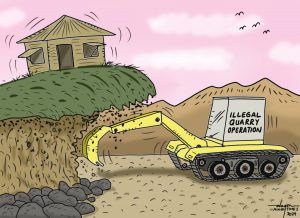Last Saturday, September 14, we embarked on a voyage that took us back in time when the early Christian missionaries first came to Davao’s shores through the formal opening of “De Navigatione” (Latin for “About the Navigation”) exhibit at the Holy Cross of Davao College (HCDC).
HCDC is “raising the sails” — a nautical term that refers to the action of hoisting the sails to harness the wind’s power to move the ship forward — towards a new era of the Archdiocese of Davao as it celebrates its 75th Diamond Jubilee this year.
The exhibit, which is on display now at the HCDC lobby until October 25, features a big replica of the ship that carried the evangelical mission that brought Catholicism to the Davao Region.
“The ship is a significant symbol of our Catholic faith,” said Archbishop Romulo Valles in his message during last Saturday’s opening.
Indeed, our very own San Pedro Cathedral is shaped like a ship and our city’s patron saint, Saint Peter, was a fisherman. To be a Christian is to be a “fisher of men” (and women), which means to bring people closer to God.
Evangelization in this part of the Philippines started in earnest only after the 1848 conquest of Davao Gulf by the expedition led by Don Jose Oyanguren.
A small church was established to cater to the religious needs of the new Christian settlement. This new church needed a priest to supervise the new mission so Oyanguren proposed to the Spanish authorities the reassignment of Recollect priest Francisco Lopez from Siargao Island to Davao to serve as the first parish priest of the Yglesia Mision de Cabezera de Bergara dela Nueva Guipuzcoa.
Davao then was named Nueva Guipuzcoa, after Oyanguren’s home province in Spain.
On June 29, 1848, Davao was dedicated to San Pedro, the patron saint of Oyanguren’s baptismal parish in Spain, and it also became the name of Davao’s first main street.
When the Recollect priest Father Lopez died in April 1849, a “core group of missionaries,” the Jesuits, became the caretaker of the mission but still under the administration of the Recollects.
Around 1850, the General Pastoral Plan of the Diocese of Cebu reported that Davao was home to only 139 individuals, mostly composed of families that joined the Oyanguren expedition.
In January 1857, San Pedro Parish was renamed Parroquia de San Pedro Apostle de Davao with Recollect priest Toribio Sanchez as parish priest.
Meanwhile, on the same year, the Bishop of Cebu reported that “once the Society of Jesus was re-established in all Spanish dominions, it should be given the spiritual administration of the districts of Bislig, Davao, Polloc, the province of Zamboanga, the island of Basilan and other places located east and south of Mindanao.” A Royal Decree was issued in 1860 creating the six politico-military districts of Mindanao that gave the Jesuits the care of these areas. Father Jose Fernandez Cuevas, first Philippine mission superior of the Society of Jesus, became the first Jesuit to visit Davao.
By October 1868, the first batch of Jesuits led by Father Ramon Barua and Father Domingo Bove arrived in Davao. San Pedro Church at that time was described as “a fairly roomy shed, but was dirty and needing repair. The school on the ground floor had two teachers paid a monthly salary of P2 each.”
The succeeding years were marked by Jesuit priests visiting all the areas in Davao and Mindanao and setting up missions. They recorded stories about their travails that included natural disasters that wiped out the settlements along the coast and rivers. They had to gather survivors and help them rebuild their lives.
They also helped in town planning and even in controlling handguns in indigenous communities. They also acted as community caregivers dealing with cases of smallpox. They served as peacekeepers and mediators of conflict.
Jesuit priest Mateo Gisbert published a Spanish-Bagobo dictionary as part of their evangelization mission in Davao. A photograph of the cover is on display at the exhibit.
The “De Navigatione” exhibit at HCDC covered only the Spanish period in the journey of the early Catholic missionaries in Davao and there are many old photographs of the Jesuit missionaries with indigenous communities.
One of the main attractions in the exhibit is the Libro de Entrierros from 1848 to 1906, the book that listed all the baptisms made at San Pedro Church. Maria Concepcion Abad y Luedes — daughter of Bernardo Luedes, a Spaniard, and Maria Abad, a Spanish mestiza — was the first to be baptized at San Pedro Parish by Father Lopez.
The succeeding parts of the journey of the Catholic Church in Davao will be showcased next by the two other Catholic schools in the city — the University of the Immaculate Conception (UIC) and the Ateneo de Davao University (ADDU) — with their own special exhibits. The period of the Basic Ecclesiastical Communities or the Gagamay nga Kristohanong Katilingban (GKK) will be showcased by San Pablo Parish. A culmination exhibit will be mounted in November in a venue that can be accessed by more people.
According to HCDC, this entire exhibition that depicts how the Archdiocese of Davao navigated the last 75 years “serves as a voyage through history by exploring our past and presenting it in a way that resonates with the present, inspiring further understanding and appreciation of our local Catholic heritage.”
And as voyages of ships go, they often encounter rough seas and tough storms, and must adjust their sails when necessary. Davao’s Catholic journey through the years is as challenging as navigating the seas and it involved a lot of adjusting the sails, changing some of the routes, but always staying the course of being fishers of people.
Whatever your religion may be, learning more about the history of the Catholic Church in Davao and how it influenced the growth and development of our city will help you understand more our Davaoeño identity.

